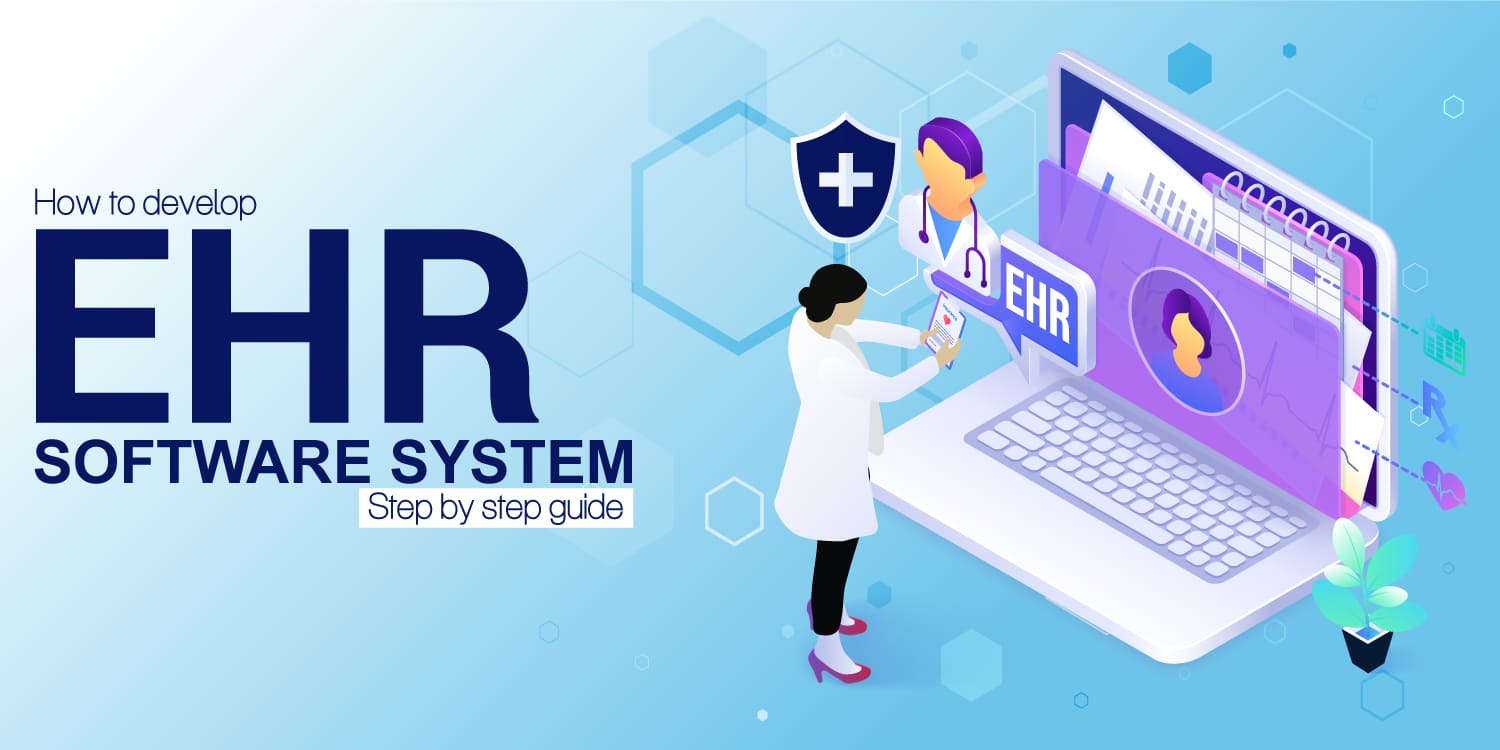An EHR software system allows doctors to reduce the amount of paperwork. It will improve productivity and can help increase revenue for healthcare establishments. Healthcare is going through a significant change with the passage of time due to digitalization. With these new technologies, you would have access to better consultations, data management & new levels of interaction that can help make other aspects of healthcare easier.
When selecting the correct EHR approach, medical organizations will face some difficulties. A health organization is distinct, and several variables may depend on criteria.
This post is an introduction to creating your own EHR software. It will teach you about the cost of building software, the tech stack involved in its development, and other important things for a healthcare business owner (which are also useful for any other type of business).
Table of Contents
ToggleWhat is An EHR Software System?
EHR meaning ‘electronic software for health information,’ is identical to EMR. The key difference between EHR and EMR is that there is far more provided by EHR schemes. EHR programs gather information from various outlets about patients, such as physicians, surgeons, laboratories, and patients. The way patients undergo medication is strengthened with such a method.
Electronic health records have been developed to enhance clinical procedures and serve patients in the age of digitalization of the healthcare sector. Data in the EHR will travel to another health facility, state, or country with the patient wherever she travels. Many EHR Software Systems also allow clinical workflow optimization that facilitates the delivery of patient care by care teams. EHR offers access to clinical information for numerous medical practitioners from different agencies.
While EHR is mainly meant for managing medical records, it would be wrong to interpret it merely as an archive of patient data. Besides permeating every phase of the patient’s path, EHR often leverages data mining to include insights from the clinic’s front desk to the drugstore to receive the medicine.
There are plenty of manufacturers on the market for EHR apps, so you are likely to find big and small implementations for any form of healthcare practice. Most of these solutions do, however, share common features.
Types of Electronic Health Record (EHR) Software
There are different types of EHR (electronic health record) software available, and each has its unique case. Here are the most common types of EHR software:
1. Cloud-based EHR
Cloud-based EHR systems are the most cost-effective and scalable systems. Most healthcare professionals prefer to use these remote servers to access patient’s data from anywhere. There’s no need for on-site server and infrastructure maintenance.
2. On-Premise EHR
On-premise EHR systems give more control over data because you are installed locally within your infrastructure. Plus, maintenance is essential with on-premise EHR systems. It’s one of the important types of EHR systems that allow you to get control over both data and systems.
3. Mobile EHR
These are the easy movable EHR systems that work on smartphones and tablets, which makes the data-sharing process much easier for healthcare professionals.
4. Web-based EHR
On the other hand, healthcare professionals can easily access web-based EHR systems through a web browser. It’s a suitable option if you’ve multiple locations or remote access.
5. Personal Health Records
It is specifically designed for patients who want to keep track of their health records, such as prescriptions, appointments, history progress, and test results.
6. Specialty-specific EHR
This type of EHR system is specially designed to fulfill the unique needs of healthcare professionals. If healthcare professionals require specialized functionalities that are not handled by the EHR system, then a specialty-specific EHR system is built.
Six Must-Have EHR Software Features
There are different types of EHR solutions built to fulfill individual functionalities. However, there are some features that every type of EHR software must have. So, here are some must-have features of EHR software that you must add during the development process:
1. Appointment Scheduling
One of the most important features of EHR software is appointment scheduling. Make sure to provide this feature, which allows patients to easily schedule an appointment with their doctors in real-time. Plus, it allows healthcare professionals to see their overall appointments in a dashboard to ensure timing is convenient for both.
2. Patient Management Portal
Another essential feature is the patient management portal. Whenever a healthcare organization builds an EHR software, this feature is essential for many operations, including new patient registration, facility transfer, discharge, etc. Plus, every patient must be assigned a unique ID after the registration to keep track of their records and make it easy to search.
3. E-Prescriptions
E-prescription is also an important feature to consider because it will help doctors and patients to seamlessly share prescriptions virtually without increasing the paperwork load and give a more detailed prescription that includes a line of treatment, condition, issues, and procedures. Doctors can easily share prescriptions with pharmacies, and patients can access prescriptions anytime.
4. Interoperability
Interoperability features are essential for those healthcare organizations that require smooth and clear communication with other healthcare systems. EHR interoperability solutions make the entire process of exchanging data between healthcare systems smooth.
5. Billing and Financial Dashboards
The most convenient way to track billing and finances in the healthcare organization is with the smart dashboard. You need to add a smart dashboard that can showcase real-time billing and financial databases and provide crucial information to make better decisions.
6. Clinical Records Section
This feature is essential in the EHR system to improve patient engagement. It provides the care teams with the instruments they need for better decision-making. So that clinicians can gather essential records like patients’ histories, examinations, surgical notes, etc. This feature is mainly used to improve the quality of care and patient outcomes.
Benefits of EHR system software for physicians and healthcare providers
You should be aware of the benefits that EHR software may bring. Before you build one for your practice, we’ve divided these into two categories – for physicians and patients.
Benefits for Physicians:
- EHRs can be accessed from anywhere worldwide and easily reinstalled after a system failure. Losing files is hard, and they can always be backed up.
- The charts are automatic, uploaded according to the preventive care guidelines they are connected with (instantly), and users get notified when an update happens.
- Some doctors may already be familiar with the benefits of electronic health records. They are so important because they help keep information like prescriptions clear and easy to read.
- Doctors can access your patients’ personal information in a specific database. This prevents them from having to waste time scanning for documentation and opens up additional ways for treatment planning to increase
Benefits for Patients:
- EHRs have empowered authorized customer service providers to provide care anytime, anywhere. This has improved patient care because patients can get their health questions answered even if they’re not at the doctor’s office.
- Many care providers opt for EHR solutions to help manage appointments and provide reminders. This can help patients and shift their workload from administrative tasks to delivering care.
- Patients may receive all their lab results, doctor’s notes, and prescriptions through EHR and EMR software. They can receive information timely with the help of developers.
- Chat is a benefit of patient-friendly EHR software. It’s crucial to make software user-friendly and ensure patients can talk with doctors when they need help.
- By editing their patient notes in EMR or EHR software, patients can select “reminders” to be sent automatically.
Advantages of an EHR
When deciding whether or not to invest in an EHR Software System, physicians need to identify if it is worth the effort accurately. They should consider the tools each system provides and understand how it will help their EHR Practice improve. Here are the advantages of EHR systems for independent practices:
1. Accessibility
Since EHRs are stored electronically, multiple providers can access them from different locations at various times. Providers can view a patient’s full medical history, track medication decisions, and control the course of care more efficiently.
In a life-threatening situation, the accessibility to electronic health records will be lifesaving. It is possible to make an accurate medical history of patient allergies, blood type, and past medical conditions-treatment decisions by viewing them.
2. Reduce Medical Error
Removing medical errors is of immense importance to doctors and patients. The EHR documentation system eliminates the problem of lost and/or misplaced patient information while simultaneously eliminating transcription data errors.
3. Less Paperwork and Fewer Storage costs
In the healthcare industry, logistical tasks reflect much time and investment. Physicians and staff may spend much of the workday filling out paperwork and sorting it. EHRs streamline the number of routine operations when they are paperless. There is also a drop in needed storage capacity as the volume of paperwork declines. When storage demands decrease and utilization improves, healthcare professionals can see their workplaces become less cluttered with instant storage and recovery of digital EHRs.
How to Build an EHR System? 5 Simple Steps
Here’s the step-by-step process to build an EHR software:
Step 1. dea Validation
The very first step you need to take is to validate the idea and make sure it’s strong and reliable. You need to keep asking important questions to validate your idea, understand what your potential competitors are doing, and know what a unique idea is to stand out from the competition. Once you know your idea is unique and has the capability to stand out, then it’s time to jump to the next step.
Step 2. EHR Model and Prototype
Now, healthcare organizations have expertise in healthcare services but not technical coding expertise. That’s why it’s preferred to hire an experienced healthcare software development company that can understand your requirements and turn your vision into reality.
So, it’s time to outline the exact requirements of your EHR software, including required features, best technology, working process, and user experience. You need to share all these requirements with the professionals and ask for a property to ensure your vision aligns with their efforts.
Step 3. Designing and Development
Once your EHR Software Development prototype is ready and found suitable, you can start the actual design and development process. As per your requirement, the development team will design and develop fully functional EHR software.
Step 4. Testing and Launch
After the development, testing plays a crucial role in ensuring that there are no flaws left while launching in the market. If any flaws arise while operating the EHR software, then the development team can immediately fix the issues. Once all the issues are resolved, you can confidently launch the EHR software on the market.
Step 5. Post-Implementation and Maintenance
Finally, your EHR software has been launched in the market, and now it’s time to learn from the feedback and make changes that your users require. Start collecting the necessary feedback from the users and improve as per the feedback. Plus, maintenance is an important part of software development to resolve any issue that arises after launching in the market to let the professional support the back.
Transform your healthcare with our EHR software
We Can Assist You! learn more about our comprehensive solution.
Ready-Made and Custom EHR Solutions
There are plenty of ready-made solutions, but most hospitals and medical providers prefer to build their own to have greater leverage over it. Let’s take a look at all of them.
Ready-made EHR solution
- The ready-made platform is designed to consider the healthcare industry’s general needs. Your every condition may or may not be fulfilled.
- Ready-made systems are modules from third parties that you can add to your framework. They need maintenance, and you will need a production team to integrate them, even though they are simpler and less expensive to build.
- Adding custom functionality is costly indicates that extra costs will be high as an end-user wants to add new features to the solution. For example, a practice may prefer voice recognition for data entry. This functionality is absent from most ready-made EHRs.
- Usually, ready-made EHR solutions are inexpensive because their cost of production is shared over a larger population, so you get what you get. As a result, the features and functions of the program have to be more basic or vastly more complicated, which could be feature-rich but ultimately requires several stuff that your business does not require.
- Affordable up-front spending. Costs for growth are distributed through a wide range of end-users. A ready-made EHR program is an appealing choice if you have a small budget.
Custom EHR solutions
- The first step is strategic preparation and analysis when designing personalized medical applications. The developer will ensure that the new technology is functional and suits the capabilities of consumers.
- By its own design, the custom solution that would fulfil each of your business requirements is very solid. The good thing about custom healthcare software is that if the cost of designing such a comprehensive framework is initially too high or the timetable for rollout is too long, you can normally start tiny and ‘layer’ features over time. This distributes prices, but earlier, the key feature gets you.
- If you go for a personalized approach, you get a perfectly acceptable EHR device suited to your needs. You and the team dictate what goes when, how the device will help the customer, how it will be built, etc. It’s much safer because little information matters, and when you want to use a ready-made solution, the capabilities and features that are included can restrict you. You also swap the possession for incorporation dependence.
- Custom EHR products are a complete collection of functions, ensuring that custom solutions provide the organization’s capabilities.
- Users don’t have to spend much time familiarizing themselves with the products. This is because, when working on the solution, custom mhealth apps engineers pay particular attention to the business procedures and expectations of the customer.
Conclusion
We hope this article has helped you better understand the complex but important EHR software system development process.
DreamSoft4u has deep expertise in creating highly efficient healthcare management systems. We can provide details on what to expect for your software and future projects. We have experience working on many different healthcare projects.
Our team includes healthcare SaaS solutions, and software focused on hospitals & practices. Our company has created a variety of software for various uses at different kinds of practices.
Please don’t hesitate to contact us if you have any questions that remain unanswered. Our IT experts will happily assist you in the journey to your perfect light EHR software system!
FAQs
Q1. What are the technical requirements for developing an EHR system?
Ans. Technical requirements for developing an EHR system include a robust database, secure network infrastructure, and EHR integration with third-party systems.
Q2. What are the regulatory compliance requirements for EHR software?
Ans.EHR software must comply with regulatory requirements like HIPAA, GDPR, and HITECH, which mandate data privacy and security, patient rights, and secure data transmission
Q3. How can I ensure data security and privacy in an EHR system?
Ans. Data security and privacy in EHR systems can be ensured by implementing encryption, access controls, secure authentication, and regular security audits.
Q4. What are the different deployment options for EHR software?
Ans. It comes down to your needs and budget. You can deploy the EHR solution on-premise, on the cloud, or as a hybrid solution.
Q5. What are the maintenance and support requirements for an EHR system?
Ans. Maintenance and support requirements for an EHR system include regular updates, bug fixes, data backups, user training, and technical support.





















